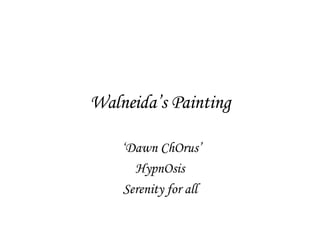Painting - Pintura
Download as ppt, pdf3 likes1,429 views
The painting by Walneida. The music is Dawn Chorus - HypnOsis
1 of 11
Downloaded 398 times











Ad
Recommended
Meditation and Hypnosis Similarities and Differences
Meditation and Hypnosis Similarities and DifferencesAnkesh Gorkhali
╠²
The document explores the similarities and differences between meditation and hypnosis, highlighting common myths and the mechanisms behind each practice. It discusses the impacts of meditation on cognitive functioning and emotional regulation, contrasting them with the short-term effects of hypnosis. Key findings suggest meditation fosters meta-awareness, while hypnosis may lead to lower awareness of mental states, and absorption is relevant to both practices.An introduction to hypnosis!
An introduction to hypnosis!Andy Clark
╠²
The document provides an introduction to hypnosis, explaining that hypnosis is a natural state and not mind control, hypnosis and stage hypnosis are different, and building rapport is important for hypnosis to work as the unconscious mind gravitates towards what it is focused on. It also discusses how the unconscious mind works, focusing on positives and being creative in getting what you want. The document advertises a hypnosis training event for learning more about hypnosis.Hypnosis & Mental Training By Dawn Grant
Hypnosis & Mental Training By Dawn Grant Dawn Grant Hypnosis Center
╠²
This document discusses hypnosis and its uses. It explains that hypnosis can be used to help people quit bad habits like smoking or drinking. It also discusses how hypnosis can help improve sports performance in activities like golf and clay shooting by helping people develop a positive mindset. The document promotes Dawn Grant, a hypnotherapist who uses hypnosis to help people overcome challenges and achieve goals related to health, habits, and performance.Cognitive Behavioral Therapy
Cognitive Behavioral Therapy Vinod Prajapati
╠²
Cognitive behavioral therapy (CBT) developed from integrating behavior therapy with cognitive psychology. CBT focuses on examining relationships between thoughts, feelings, and behaviors. It has been shown to effectively treat many conditions including mood, anxiety, personality, eating, substance abuse, and psychotic disorders. CBT involves actively working with a therapist to challenge unhelpful thoughts and behaviors. While effective, CBT requires patient commitment and may initially increase anxiety when confronting problems.The Art of Covert Hypnosis pdf
The Art of Covert Hypnosis pdfConradDrake
╠²
The document is a guide to covert hypnosis, outlining techniques for inducing trance states in individuals through everyday conversation to influence and persuade them. It emphasizes the importance of setting clear objectives and building rapport as essential components of effective covert hypnosis. Additionally, it introduces an audio course by Igor Ledochowski as a resource for mastering conversational hypnosis skills.Complete presentation by KIRAN SHAUKAT
Complete presentation by KIRAN SHAUKATKiran Shaukat
╠²
Hypnosis is a mental state usually induced by a hypnotic induction involving suggestions. It can be used therapeutically as hypnotherapy. There are different types of hypnosis including traditional, self, NLP, and Ericksonian hypnosis. Hypnosis is used clinically for issues like phobias, smoking cessation, weight control, confidence and anxiety. While it has benefits, it also has disadvantages and risks if not used properly by a trained professional.Four major types of psychotherapy
Four major types of psychotherapysstout08
╠²
There are four major types of psychotherapy: psychoanalysis developed by Freud to treat neurotic symptoms, humanistic therapy which emphasizes human potential pioneered by Carl Rogers, Gestalt therapy founded by Max Wertheimer that views the whole as greater than parts, and behavior theory developed by Skinner in 1953 using techniques like self-monitoring and role playing. Cognitive therapy developed by Aaron Beck in the 1960s seeks to change dysfunctional thinking to treat depression.Hypnosis
Hypnosisbalntyn
╠²
- Hypnosis is a trance state characterized by extreme suggestibility, relaxation and heightened imagination where the person is fully aware but intensely focused on the hypnotist.
- It does not affect free will as people will not do things opposed to their morals, but they are highly suggestible to what the hypnotist suggests.
- Psychoanalytic theory views hypnosis as putting the conscious mind at rest to allow the unconscious mind to be accessed more directly through suggestion.
- Different personality theories like behavioral and cognitive approaches help explain hypnosis through concepts of learning, expectation, and mental processing.Covert Hypnosis Techniques pdf
Covert Hypnosis Techniques pdfConradDrake
╠²
The document provides an overview of covert hypnosis techniques used to influence and command people during conversation through subtle language patterns, without the subject's awareness. It discusses key methods such as nested loops, embedded commands, and the importance of voice tonality in inducing trance states. Additionally, it highlights the pioneering work of Milton Erickson in conversational hypnosis and offers practical tips for effective implementation of these techniques.Models of psychotherapy
Models of psychotherapy║▌║▌▀Żshare by NBD (naorem binita devi)
╠²
The document discusses several major models of psychotherapy:
1) Psychodynamic model (Sigmund Freud), Cognitive-Behavioral model (Albert Ellis, Aaron Beck), Existential-Humanistic model (Carl Rogers, Rollo May), and Multicultural model.
2) Key techniques discussed include free association, dream analysis, cognitive restructuring, Socratic questioning, reflection, and confrontation used in therapies like psychoanalysis, CBT, person-centered therapy and rational emotive behavior therapy.
3) The cognitive-behavioral and rational emotive behavior therapy models make use of techniques like systematic desensitization, modeling, and disputing irrational beliefs through logical arguments.Applications Of CBT In Group Therapies
Applications Of CBT In Group TherapiesKevin J. Drab
╠²
Cognitive-behavioral group therapy (CBGT) uses cognitive and behavioral techniques to help clients change maladaptive thought and behavior patterns. Key techniques include identifying automatic thoughts and cognitive distortions, monitoring moods and behaviors, relaxation, problem-solving, and relapse prevention. CBGT is effective because it allows clients to learn from others, get feedback, and practice skills in a social context while also receiving individual attention from the therapist.Cognitive behavior therapy
Cognitive behavior therapyMarcelo Araya Gonz├Ālez
╠²
This book provides detailed descriptions of cognitive behavioral therapy techniques. It aims to fill a gap in training students and practitioners by providing a comprehensive collection of CBT methods in one volume. The book also seeks to address the increasing misapplication of techniques due to a lack of understanding of how to properly implement them. It takes an inclusive approach, including both cognitive and behavioral techniques. The goal is to equip readers with knowledge of the complexities of faithfully applying these evidence-based psychotherapy techniques.How Hypnosis Works
How Hypnosis WorksIgor Ledochowski
╠²
Curious how hypnosis really works? Check out this short slideshow on the power of your unconscious mind from the Hypnosis Training Academy!Cognitive Behavioral Therapy Simplified
Cognitive Behavioral Therapy SimplifiedThe Mind Faculty
╠²
Cognitive behavioral therapy (CBT) is a type of psychotherapy that helps people change unhelpful thinking and behavior patterns. The document outlines the main features and basic structure of CBT. It discusses behavioral techniques like relaxation, distraction, and activity scheduling. It also covers cognitive techniques such as identifying negative thoughts, cognitive restructuring to develop more realistic perspectives, and addressing underlying assumptions. The goal of CBT is to help clients learn to challenge irrational beliefs and thoughts in order to change emotional responses and behaviors.How to Hypnotize - Complete Hypnotism, Mesmerism, Mind-reading and Spiritualism
How to Hypnotize - Complete Hypnotism, Mesmerism, Mind-reading and SpiritualismAlfa Centauri
╠²
The document is an extensive exploration of the history and development of hypnotism, tracing its origins from ancient practices such as mesmerism to modern understandings introduced by figures like James Braid. It highlights the controversies surrounding hypnotism, including the debates on whether its effects are due to external forces or suggestive psychological states. Ultimately, it establishes hypnotism as a legitimate area of scientific inquiry, differentiating it from earlier magnetism theories while acknowledging its foundational role in contemporary studies of the mind.Basics of cognitive behavioral therapy
Basics of cognitive behavioral therapyCenter for Cognitive and Behavioral Therapy of Greater Columbus
╠²
The document summarizes the basics of cognitive-behavioral therapy (CBT), including its model and techniques.
CBT is based on a bio-psycho-social model that views psychopathology as stemming from maladaptive cognitions and behaviors learned through "if-then" schemas. Treatment involves identifying distorted thoughts, or "automatic thoughts", in three cognitive categories - self, others/world, future. CBT aims to overcome "cognitive blockades" and replace distortions with evidence-based thinking through collaborative, Socratic questioning between the patient and therapist. Common techniques include activity scheduling, thought monitoring/challenging, and behavioral experiments.Hypnosis ║▌║▌▀Żs
Hypnosis ║▌║▌▀ŻsEric Castro
╠²
This document discusses several questions about hypnosis:
1. Can anyone experience hypnosis? Yes, everyone is suggestible to some degree, though 20% can be highly hypnotized. Those most susceptible tend to have rich fantasy lives.
2. Can hypnosis enhance recall of forgotten events? No, demonstrations of "age regression" are often overperformed and hypnotically refreshed memories are inadmissible. Memory does not record everything perfectly.
3. Can hypnosis force people to act against their will? No, but an authoritative person can induce even unhypnotized people to perform unlikely acts, though hypnotized subjects' behaviors remain within normal limits.Psychotherapy
PsychotherapySathish Rajamani
╠²
Psychotherapy is the treatment of emotional or related bodily problems through psychological means such as verbal and emotional communication. Its objectives include removing or modifying existing symptoms, changing disturbed behavior patterns, and promoting positive personality growth. Psychotherapy can be scientific or an art. As a science, it focuses on problems and treatment using techniques like interpretation and behavior modification. As an art, it focuses on prevention using techniques like emotional support and reassurance. There are different types of psychotherapy based on depth of probing into the unconscious mind and number of patients treated, as well as purpose and techniques used. Common techniques include ventilation, abreaction, reassurance, explanation, suggestion, reinforcement, recreation, work as therapy, and relaxation.Cognitive behavioral therapy
Cognitive behavioral therapyJoshua Batalla
╠²
The document outlines the principles of cognitive therapy as developed by Aaron T. Beck, emphasizing that psychological issues arise from faulty thinking and cognitive distortions. It details how cognitive therapy is a short-term, present-focused approach that has effectively treated various psychological disorders, especially depression. Additionally, the document discusses various therapeutic techniques, the cognitive model, and the importance of identifying and challenging automatic and dysfunctional thoughts.CBT
CBTAndrew Scott
╠²
Cognitive behavioral therapy (CBT) uses a combination of behavioral and cognitive techniques to address dysfunctional emotions, maladaptive behaviors, and cognitive processes. CBT aims to teach people that they can control their thoughts, feelings, and behaviors. Through challenging automatic beliefs and using practical strategies, CBT helps patients modify their behavior and thoughts, leading to more positive feelings and a learning process. CBT is effective for treating conditions like phobias, addictions, schizophrenia, and depression.Introduction of psychotherapy
Introduction of psychotherapyNursing Path
╠²
The document defines psychotherapy as a treatment method that involves developing an intimate therapeutic relationship between a client and therapist to explore and modify client behavior in a satisfying direction. It further describes psychotherapy as a process where a person seeks to resolve problems or issues by interacting with a psychotherapist in a prescribed way.Conversational Hypnosis Techniques PDF
Conversational Hypnosis Techniques PDFConradDrake
╠²
The document discusses covert hypnosis, also known as conversational hypnosis, as a technique to influence people through ordinary conversations. It highlights the methods and benefits of this skill, such as the ability to persuade others and induce trance states without their awareness. Recommendations for learning conversational hypnosis through courses and practices are also provided, emphasizing its potential for both good and ill.Hypnosis theory and practice
Hypnosis theory and practicePS Deb
╠²
Hypnosis is an induced altered state of consciousness characterized by heightened focus and suggestibility. It can be self-induced through activities like daydreaming or meditation, or induced by a hypnotist through relaxation and focused attention techniques. While some myths exist around hypnosis involving mind control, research shows subjects maintain voluntary control and hypnosis simply involves using imagination and suggestion to influence perceptions, sensations, and behaviors. Hypnosis has various therapeutic and medical applications and any willing person of average intelligence can experience it, though some are more suggestible than others. Risks are small but safeguards like pre-hypnosis screening are recommended.Cognitive behavior therapy theory and practice
Cognitive behavior therapy theory and practiceWuzna Haroon
╠²
Cognitive behavioral therapy (CBT) was developed in the 1960s by Aaron Beck based on his research challenging the psychoanalytic view of depression. Beck observed that depressed clients had negative biases in interpreting events that contributed to cognitive distortions. He developed CBT which focuses on identifying and modifying dysfunctional thoughts and beliefs. The key assumptions of CBT are that cognitions influence behaviors and emotions, and that maladaptive thinking can be identified and changed. Common techniques include cognitive restructuring to challenge irrational thoughts, behavioral experiments, and homework assignments.Make any girl want to fuck
Make any girl want to fuckphilipss clerke
╠²
The document discusses 'innocent' trigger words that can provoke sexual attraction in women without making the conversation seem overtly sexual. It emphasizes the power of language to evoke emotions and images, providing examples of how to incorporate these words into everyday conversations to ignite interest. The text urges users to practice these phrases to enhance their interactions, implying effectiveness across different types of women.Reflections
ReflectionsBeth Arr
╠²
The document reflects on daylight reflecting lights and how at night we are shadows. It also includes a music reference to the song "Tchubaruba" by Brazilian artist Mallu Magalh├Żes.Graduation - Formatura Beth Arr
╠²
O ├Īlbum de formatura de Fl├Īvia Moreira Arroio do curso de Nutri├¦├Żo da UNiRP em 2007 apresenta a m├║sica "Bachianas Brasileiras" do compositor Heitor Villa-Lobos.Wal's Painting II
Wal's Painting IIBeth Arr
╠²
This short document appears to be sharing information about an artwork titled "Walneida's Painting II" by an artist and their friend, and recommends listening to the music "Valzer Dottore" by the group Quadro Nuevo while viewing the art. It also includes a website link.More Related Content
Viewers also liked (17)
Covert Hypnosis Techniques pdf
Covert Hypnosis Techniques pdfConradDrake
╠²
The document provides an overview of covert hypnosis techniques used to influence and command people during conversation through subtle language patterns, without the subject's awareness. It discusses key methods such as nested loops, embedded commands, and the importance of voice tonality in inducing trance states. Additionally, it highlights the pioneering work of Milton Erickson in conversational hypnosis and offers practical tips for effective implementation of these techniques.Models of psychotherapy
Models of psychotherapy║▌║▌▀Żshare by NBD (naorem binita devi)
╠²
The document discusses several major models of psychotherapy:
1) Psychodynamic model (Sigmund Freud), Cognitive-Behavioral model (Albert Ellis, Aaron Beck), Existential-Humanistic model (Carl Rogers, Rollo May), and Multicultural model.
2) Key techniques discussed include free association, dream analysis, cognitive restructuring, Socratic questioning, reflection, and confrontation used in therapies like psychoanalysis, CBT, person-centered therapy and rational emotive behavior therapy.
3) The cognitive-behavioral and rational emotive behavior therapy models make use of techniques like systematic desensitization, modeling, and disputing irrational beliefs through logical arguments.Applications Of CBT In Group Therapies
Applications Of CBT In Group TherapiesKevin J. Drab
╠²
Cognitive-behavioral group therapy (CBGT) uses cognitive and behavioral techniques to help clients change maladaptive thought and behavior patterns. Key techniques include identifying automatic thoughts and cognitive distortions, monitoring moods and behaviors, relaxation, problem-solving, and relapse prevention. CBGT is effective because it allows clients to learn from others, get feedback, and practice skills in a social context while also receiving individual attention from the therapist.Cognitive behavior therapy
Cognitive behavior therapyMarcelo Araya Gonz├Ālez
╠²
This book provides detailed descriptions of cognitive behavioral therapy techniques. It aims to fill a gap in training students and practitioners by providing a comprehensive collection of CBT methods in one volume. The book also seeks to address the increasing misapplication of techniques due to a lack of understanding of how to properly implement them. It takes an inclusive approach, including both cognitive and behavioral techniques. The goal is to equip readers with knowledge of the complexities of faithfully applying these evidence-based psychotherapy techniques.How Hypnosis Works
How Hypnosis WorksIgor Ledochowski
╠²
Curious how hypnosis really works? Check out this short slideshow on the power of your unconscious mind from the Hypnosis Training Academy!Cognitive Behavioral Therapy Simplified
Cognitive Behavioral Therapy SimplifiedThe Mind Faculty
╠²
Cognitive behavioral therapy (CBT) is a type of psychotherapy that helps people change unhelpful thinking and behavior patterns. The document outlines the main features and basic structure of CBT. It discusses behavioral techniques like relaxation, distraction, and activity scheduling. It also covers cognitive techniques such as identifying negative thoughts, cognitive restructuring to develop more realistic perspectives, and addressing underlying assumptions. The goal of CBT is to help clients learn to challenge irrational beliefs and thoughts in order to change emotional responses and behaviors.How to Hypnotize - Complete Hypnotism, Mesmerism, Mind-reading and Spiritualism
How to Hypnotize - Complete Hypnotism, Mesmerism, Mind-reading and SpiritualismAlfa Centauri
╠²
The document is an extensive exploration of the history and development of hypnotism, tracing its origins from ancient practices such as mesmerism to modern understandings introduced by figures like James Braid. It highlights the controversies surrounding hypnotism, including the debates on whether its effects are due to external forces or suggestive psychological states. Ultimately, it establishes hypnotism as a legitimate area of scientific inquiry, differentiating it from earlier magnetism theories while acknowledging its foundational role in contemporary studies of the mind.Basics of cognitive behavioral therapy
Basics of cognitive behavioral therapyCenter for Cognitive and Behavioral Therapy of Greater Columbus
╠²
The document summarizes the basics of cognitive-behavioral therapy (CBT), including its model and techniques.
CBT is based on a bio-psycho-social model that views psychopathology as stemming from maladaptive cognitions and behaviors learned through "if-then" schemas. Treatment involves identifying distorted thoughts, or "automatic thoughts", in three cognitive categories - self, others/world, future. CBT aims to overcome "cognitive blockades" and replace distortions with evidence-based thinking through collaborative, Socratic questioning between the patient and therapist. Common techniques include activity scheduling, thought monitoring/challenging, and behavioral experiments.Hypnosis ║▌║▌▀Żs
Hypnosis ║▌║▌▀ŻsEric Castro
╠²
This document discusses several questions about hypnosis:
1. Can anyone experience hypnosis? Yes, everyone is suggestible to some degree, though 20% can be highly hypnotized. Those most susceptible tend to have rich fantasy lives.
2. Can hypnosis enhance recall of forgotten events? No, demonstrations of "age regression" are often overperformed and hypnotically refreshed memories are inadmissible. Memory does not record everything perfectly.
3. Can hypnosis force people to act against their will? No, but an authoritative person can induce even unhypnotized people to perform unlikely acts, though hypnotized subjects' behaviors remain within normal limits.Psychotherapy
PsychotherapySathish Rajamani
╠²
Psychotherapy is the treatment of emotional or related bodily problems through psychological means such as verbal and emotional communication. Its objectives include removing or modifying existing symptoms, changing disturbed behavior patterns, and promoting positive personality growth. Psychotherapy can be scientific or an art. As a science, it focuses on problems and treatment using techniques like interpretation and behavior modification. As an art, it focuses on prevention using techniques like emotional support and reassurance. There are different types of psychotherapy based on depth of probing into the unconscious mind and number of patients treated, as well as purpose and techniques used. Common techniques include ventilation, abreaction, reassurance, explanation, suggestion, reinforcement, recreation, work as therapy, and relaxation.Cognitive behavioral therapy
Cognitive behavioral therapyJoshua Batalla
╠²
The document outlines the principles of cognitive therapy as developed by Aaron T. Beck, emphasizing that psychological issues arise from faulty thinking and cognitive distortions. It details how cognitive therapy is a short-term, present-focused approach that has effectively treated various psychological disorders, especially depression. Additionally, the document discusses various therapeutic techniques, the cognitive model, and the importance of identifying and challenging automatic and dysfunctional thoughts.CBT
CBTAndrew Scott
╠²
Cognitive behavioral therapy (CBT) uses a combination of behavioral and cognitive techniques to address dysfunctional emotions, maladaptive behaviors, and cognitive processes. CBT aims to teach people that they can control their thoughts, feelings, and behaviors. Through challenging automatic beliefs and using practical strategies, CBT helps patients modify their behavior and thoughts, leading to more positive feelings and a learning process. CBT is effective for treating conditions like phobias, addictions, schizophrenia, and depression.Introduction of psychotherapy
Introduction of psychotherapyNursing Path
╠²
The document defines psychotherapy as a treatment method that involves developing an intimate therapeutic relationship between a client and therapist to explore and modify client behavior in a satisfying direction. It further describes psychotherapy as a process where a person seeks to resolve problems or issues by interacting with a psychotherapist in a prescribed way.Conversational Hypnosis Techniques PDF
Conversational Hypnosis Techniques PDFConradDrake
╠²
The document discusses covert hypnosis, also known as conversational hypnosis, as a technique to influence people through ordinary conversations. It highlights the methods and benefits of this skill, such as the ability to persuade others and induce trance states without their awareness. Recommendations for learning conversational hypnosis through courses and practices are also provided, emphasizing its potential for both good and ill.Hypnosis theory and practice
Hypnosis theory and practicePS Deb
╠²
Hypnosis is an induced altered state of consciousness characterized by heightened focus and suggestibility. It can be self-induced through activities like daydreaming or meditation, or induced by a hypnotist through relaxation and focused attention techniques. While some myths exist around hypnosis involving mind control, research shows subjects maintain voluntary control and hypnosis simply involves using imagination and suggestion to influence perceptions, sensations, and behaviors. Hypnosis has various therapeutic and medical applications and any willing person of average intelligence can experience it, though some are more suggestible than others. Risks are small but safeguards like pre-hypnosis screening are recommended.Cognitive behavior therapy theory and practice
Cognitive behavior therapy theory and practiceWuzna Haroon
╠²
Cognitive behavioral therapy (CBT) was developed in the 1960s by Aaron Beck based on his research challenging the psychoanalytic view of depression. Beck observed that depressed clients had negative biases in interpreting events that contributed to cognitive distortions. He developed CBT which focuses on identifying and modifying dysfunctional thoughts and beliefs. The key assumptions of CBT are that cognitions influence behaviors and emotions, and that maladaptive thinking can be identified and changed. Common techniques include cognitive restructuring to challenge irrational thoughts, behavioral experiments, and homework assignments.Make any girl want to fuck
Make any girl want to fuckphilipss clerke
╠²
The document discusses 'innocent' trigger words that can provoke sexual attraction in women without making the conversation seem overtly sexual. It emphasizes the power of language to evoke emotions and images, providing examples of how to incorporate these words into everyday conversations to ignite interest. The text urges users to practice these phrases to enhance their interactions, implying effectiveness across different types of women.More from Beth Arr (9)
Reflections
ReflectionsBeth Arr
╠²
The document reflects on daylight reflecting lights and how at night we are shadows. It also includes a music reference to the song "Tchubaruba" by Brazilian artist Mallu Magalh├Żes.Graduation - Formatura Beth Arr
╠²
O ├Īlbum de formatura de Fl├Īvia Moreira Arroio do curso de Nutri├¦├Żo da UNiRP em 2007 apresenta a m├║sica "Bachianas Brasileiras" do compositor Heitor Villa-Lobos.Wal's Painting II
Wal's Painting IIBeth Arr
╠²
This short document appears to be sharing information about an artwork titled "Walneida's Painting II" by an artist and their friend, and recommends listening to the music "Valzer Dottore" by the group Quadro Nuevo while viewing the art. It also includes a website link.Ad
Recently uploaded (20)
Cell Injuri. pathophpysiology sem- II B Pharmacypptx
Cell Injuri. pathophpysiology sem- II B PharmacypptxUmeshMali25
╠²
This presentation provides a comprehensive overview of cell injury, a fundamental concept in pathology. It covers the causes, types (reversible and irreversible), mechanisms of injury (including hypoxia, free radicals, and chemical agents), and the morphological and biochemical changes that occur during cell injury. The slides are ideal for medical, pharmacy, and life sciences students preparing for pathology coursework or exams.
REFRAMING OF EXPERTISE AND INFORMATION IN HEALTH
REFRAMING OF EXPERTISE AND INFORMATION IN HEALTHTina Purnat
╠²
A talk I gave at CDIC 2025 on how information and expertise in health are being reframed and how this demands change from public health.Multidisciplinary Strategies in GDMT Implementation
Multidisciplinary Strategies in GDMT ImplementationDuke Heart
╠²
Aferdita Spahillari, MD
Duke University 5-Lift Analysis in ergonomics focuses on evaluating the safety and efficienc...
5-Lift Analysis in ergonomics focuses on evaluating the safety and efficienc...Bolan University of Medical and Health Sciences ,Quetta
╠²
Lift Analysis in ergonomics focuses on evaluating the safety and efficiency of manual lifting tasks in the workplace. It involves assessing the physical demands placed on the human body during lifting activities to prevent musculoskeletal disorders (MSDs), particularly lower back injuriesAbnormal Uterine Bleeding and its Management
Abnormal Uterine Bleeding and its ManagementChandrika Kulkarni
╠²
Abnormal Uterine Bleeding and its ManagementDRUGS USED IN UTI OR URINARY ANTISEPTICS
DRUGS USED IN UTI OR URINARY ANTISEPTICSUmanath Singh Autonomous State Medical College, Jaunpur
╠²
drugs used in Urinary Tract InfectionsCOUGH AND THIER DRUGS AND MODE OF ACTION.pptx
COUGH AND THIER DRUGS AND MODE OF ACTION.pptxPackialakshmiP
╠²
COUGH AND THIER DRUGS AND MODE OF ACTIONInferential statistics-part 2Chi-Square Test
Inferential statistics-part 2Chi-Square TestBabitha Devu
╠²
Inferential Statistics Part - 2 deals with Nonparametric test.
Only Chi-square is discussed here. Self-Awareness and Self-Care How Professionals Can Avoid Burnout
Self-Awareness and Self-Care How Professionals Can Avoid BurnoutOlaf Kraus de Camargo
╠²
Closing Keynote at the IV OG├ōLNOPOLSKA KONFERENCJA & WARSZTATY
KomunikAACja, Samoswiadomosc, Seksualnosc
June 13th ŌĆō 14th, 2025
An overview of the definition and presentation of burnout in healthcare workers, strategies to prevent it and to build resilience. The presentation also explores the barriers and enablers to introducing wellness strategies in organizations.Ratricharya according to ayurveda along with day and night pattern in various...
Ratricharya according to ayurveda along with day and night pattern in various...DR DHARMENDRA BINJHWAR
╠²
This slide are more importents for ayurveda students and teachers because i have mentioned in this slide night time routine in ayurveda the ancient science of India along with day and night pattern in various counteries within in one ppt. thanks for watching i will be greatful for your suggestion and feedback... please like share and suppourtGeneral Pharmacology
General Pharmacology Umanath Singh Autonomous State Medical College, Jaunpur
╠²
This is ppt of general pharmacology and its aspectwhooping cough community health nursing.
whooping cough community health nursing.ASWIN S
╠²
Whooping cough for BSC 5th sem community health nursing..
This includes
Introduction
Definition
Incidence
Incubation period
Causes
Clinical manifestations
Diagnostic evaluation
Treatment
Prevention
Complications
Of whooping cough....JAUNDICE,BIOCHEMISTRY, FIRST MBBS STUDENTS
JAUNDICE,BIOCHEMISTRY, FIRST MBBS STUDENTSamitarathore081986
╠²
JAUNDICE IS A SYMPTOM, NOT A DISEASE JAUNDICE, YELLOWISH DISCOLORATION OF SKIN, MUCOUS MEMBRANES &SCLERA DUE TO ELEVATED BILIRUBIN IN BLOOD
When is the Right Time to Refer to (Advanced) Heart Failure?
When is the Right Time to Refer to (Advanced) Heart Failure?Duke Heart
╠²
Adam DeVore, MD, MHS
Duke University Drugs Acting on the Autonomic Nervous System ŌĆō Classification, Properties & Uses
Drugs Acting on the Autonomic Nervous System ŌĆō Classification, Properties & UsesSajini
╠²
This presentation offers a comprehensive overview of drugs acting on the autonomic nervous system (ANS), including sympathomimetic, sympatholytic, parasympathomimetic, and anticholinergic agents. It explains the classification, mechanism of action, properties, formulation, brand names, and clinical uses of key drugs like adrenaline, dopamine, propranolol, atropine, and pilocarpine. Ideal for students and professionals in pharmacy, medicine, and healthcare.Exomind in General Aesthetics - with June 10, 2025 updates
Exomind in General Aesthetics - with June 10, 2025 updateslcadymd1
╠²
Hi. This is Dr. Cady writing. This is the updated presentation compared to the original one given in Hong Kong on June 3rd. The rationale behind the update is my further reflection on the interesting concept of "mental wellness" which has been identified as a treatment target with a modified TMS protocol developed by BTL. It should be clearly noted that this device is definitely approved in the USA for the treatment of depression according to old TMS protocols. The "depression protocol" involves a minimum of 30 treatments, administered over 5 - 6 weeks, with one treatment typically on every weekday (M-F).
In contrast, the "wellness protocol" developed by BTL for this device has been successfully used in a study on "mental wellness" with just FOUR treatments administered, and in the study for food cravings and self control with just SIX treatments administered. Additionally, I demonstrate in this presentation the remarkable power of this TMS device to eliminate depression and anxiety in two patients presented after just two back to back treatments.
It should be clearly noted that this is not an official BTL protocol, nor the position of the company, and the use of this device for mental wellness is not "FDA approved." It is also not FDA approved for the aggressive treatment protocol I share in this presentation. Given that this device is used per physician discretion, and given that the scientific literature supports the idea that the more pulses or treatments delivered in a day increase the effectiveness of the treatment and the rapidity of onset, this aggressive treatment seemed to me to be scientifically valid, and safe. Scrupulous informed consent was obtained from the patients prior to administering the treatments in the manner I have illustrated herein. I am not necessasrily recommending tretments in this manner. But I include them and note them because they reveal, dramatically, the capability of this device to change people's lives with the most serious cases. The impact, therefore, on just "lack of mental wellness" or "food cravings and impulse control is very reasonable.
It is my belief that 4 - 6 treatments in a general aesthetic or "wellness" practice should be sufficient. For the harder cases that a psychiatrist would see, there is some argument that even six treatments, administered with three "couplet" or "paired" treatments, could be remarkably beneficial.
In this presentation, I review the epidemiology of depression, anxiety and the topic of simply being "mentally unwell" while not being necessarily diagnosed with depression or anxiety. It is the lack of mental wellness and addressing it with this helpful modality that is so tremendously exciting.
A rough comparison of the relative treatment potency and effects of the Exomind versus older technology is included, pointing the way toward the logical assumption that, indeed, merely a few treatments (4 - 6) could have significant benefits in our patients.ADRENERGIC SYSTEM AND RELATED DRUGS LIKE ADRENALINE
ADRENERGIC SYSTEM AND RELATED DRUGS LIKE ADRENALINEUmanath Singh Autonomous State Medical College, Jaunpur
╠²
Noradrenaline/ Norepinephrine: It is a transmitter at postganglionic sympathetic sites (except sweat glands, hair follicles and some vasodilator fibres) and in certain areas of brain.
Adrenaline/ Epinephrine: It is secreted by adrenal medulla and may have a transmitter role in the brain.
Dopamine: It is a major transmitter in basal ganglia, limbic system, CTZ, anterior pituitary, etc.
5-Lift Analysis in ergonomics focuses on evaluating the safety and efficienc...
5-Lift Analysis in ergonomics focuses on evaluating the safety and efficienc...Bolan University of Medical and Health Sciences ,Quetta
╠²
Ratricharya according to ayurveda along with day and night pattern in various...
Ratricharya according to ayurveda along with day and night pattern in various...DR DHARMENDRA BINJHWAR
╠²
ADRENERGIC SYSTEM AND RELATED DRUGS LIKE ADRENALINE
ADRENERGIC SYSTEM AND RELATED DRUGS LIKE ADRENALINEUmanath Singh Autonomous State Medical College, Jaunpur
╠²
Ad
